The 1953 'hartal' and aftermath of Leftist movement
By W. T. A. Leslie FERNANDO
After the shattering defeat of the LSSP at the 1952 general election,
there was a tendency among a group in the LSSP to form a unity among the
anti-UNP forces. This was brewing in them when the CP-VLSSP United Front
formed. At the beginning they wanted unity among the Leftist parties.
At the LSSP conference held in October 1952, the resolution for a
unity among the progressives was defeated but it was decided to have
negotiations with other working class parties for a united front of the
Left. Accordingly in November 1952, the LSSP invited delegations from
the CP-VLSSP United Front and the Ceylon Indian Congress for a
discussion.
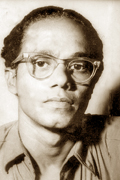 |
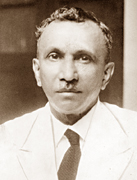 |
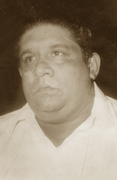 |
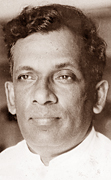 |
| Stanley
Tillekaratne |
Gate
Mudliyar de Alwis |
Reggie
Perera |
William de Silva |
At the discussion the CP-VLSSP United Front insisted that there
should be unconditional support for the Communist bloc and there should
be a broad-based unity of the anti-UNP forces. However the initial
discussions they had between the LSSP and the CP-VLSSP United Front
failed because the LSSP was not willing to surrender its right to
criticise the bureaucracy of the Communist countries.
In 1953, the balance of payments in Sri Lanka received a setback as
the prices of the exports decreased and that of the imports increased.
The Korean boom came to an end once the Korean War was over and the
government aimed to withdraw most of the subsidies to conserve foreign
resources. It wanted to restrict the import of rice and wheat flour. The
speculation of these measures created artificial scarcities.
The real gravity of the situation came to the surface when in 1953,
the budget proposals were introduced. The price of subsidised measure of
rice was increased from 25 cents to 70 cents. The price of sugar and
wheat flour too went up. There were drastic increase of presto rates and
the train fare. The free mid-day bun was also withdrawn and
approximately 750,000 schoolchildren were affected. Nevertheless no
burdens were imposed on the rich.
The total effect of these measures were devastating to the poor. As
all these came together the situation became worse for them. The
affected both the rural and urban poor alike and these was discontent
among them. The Leftist parties galvanized the people against the
measures. They organised protest rallies processions, pamphlets and
trade union action.
On July 23, 1953 the Leftists organised huge protest rally at the
Galle Face grounds. It was presided over by S. W. R. D. Bandaranaike. On
that day the LSSP and the CP-VLSSP United Front organised a strike in
the Port. Some people who attended the mammoth rally stormed the
Parliament buildings and the Police had to use tear gas to disperse
them.
The LSSP, CP-VLSSP United Front and the Federal Party continued their
agitations all over the country. They decided to organise a Hartal on
August 12, 1953 as a mark of protest. Although the SLFP associated with
the protests, they did not actively support the 'hartal' fearing some
violence. Nevertheless the Federal Party joined the Hartal and as such
it was not confide only to the Leftists.
The LSSP, CP-VLSSP United Front and the Federal Party got together
and decided that the 'hartal' should be a peaceful protest without
violence, a countrywide stoppage of work for one day and a day of
mourning hoisting black flags. On the other hand the government and the
private employees took counter measures to repulse people from
participating in the Hartal.
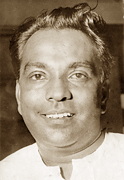 |
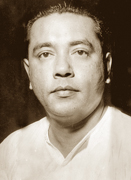 |
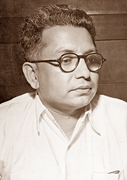 |
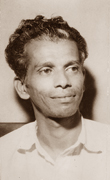 |
| Lakshman
Rajapakse |
D. F. Hettiarachchi |
T. B. Subasinghe |
L. W. Panditha |
On the Hartal Day on August 12, 1953 there was a standstill in many
public and private institutions. The transport strike was so successful
that even the few who reported for work in Colombo could not return
home. Garbage collection, post and harbour operations were all paralysed.
This situation prevailed mostly in the coastal belt along Western and
Southern provinces.
The people took 'hartal' beyond stoppage of work. They blocked roads,
removed rail tracks, brought down telegraph posts and even stoned and
burnt buses. When the Police went to quell the riotous behaviour, they
were stoned. Shops were closed in many towns. Incidents of this kind
occurred even in the North.
Although the 'hartal' was meant for one day, the protests and riotous
behaviour continued unabated. The treatment meted out by the Police to
protests, angered people and troubled continued. The LSSP and the CP-VLSSP
leaders found that the situation had gone out of control and issued a
statement that the 'hartal' is over and calling workers to resume
duties. However the protests continued at a high pitch for several more
days and the Police had to shoot eight people dead to control the
situation. Hundreds were arrested including some Leftist leaders in some
provinces.
Many acts of violence occurred during the 'hartal'. The government
had to take stern measures to put an end to the 'hartal'. On August 14,
it announced the death penalty for arson, looting and trespass and 20
years jail for sedition. These very steep penalties showed that the 'hartal'
made the establishment uneasy.
1953 Hartal was a significant event in the history of Sri Lanka. This
was the first occasion that the people rose in protest and some with
violence, to show their discontent against a government. Some interpret
that the hartal proved that the people could have been organised for a
revolution as envisaged by the LSSP. They analyse that though the people
were ready for a revolution, the Leftist leaders were not prepared to
direct the people towards it.
Others contend that the categorisation of 'hartal' was a condition
ripe for a revolution was really an exaggeration of events that occurred
which were in the main restricted to Western, Southern and Sabaragamuwa
provinces although there were few incidents in the North. They point out
that protests came only from the elements faithful to the Leftists and
vast mass of people although opposed to cuts in the subsidy did not
participate in the 'hartal'. They add that the major trade unions in the
plantations had nothing to do with the 'hartal'.
Whatever the revolutionary potential of hartal, it was very
effective. The government was compelled to reduce the prize of consumer
goods to some extent. It gave rise to jittery in the government ranks.
Dudley Senanayake resigned after the 'hartal' and Sir John Kotalawela
was made the Prime Minister. The 'hartal' symbolised the resentment of
people towards the government and paved the way for the debacle of the
UNP in 1956. Although the Leftist leaders disowned the violence at the 'hartal'
the LSSP leaders proudly proclaimed that it was the first occasion that
the masses revolted against the capitalist domination.
The success of the 'hartal' strengthened the group within the LSSP
that called for a Left unity. They maintained that leaving aside the
theoretical jargon a unity of the progressives should be effected under
a Left leadership. The leadership of the LSSP interpreted that the 'hartal'
demonstrated the potentiality of a general uprising that would lead to a
revolution. The LSSP leadership was intransigent to a Left unity.
At the LSSP conference held in October 1953, two sets of resolutions
were mooted. The proposals the party leadership read that
internationally the party should support the socialist bloc but there is
bureaucracy in them and the party should support the workers in them in
an uprising against the bureaucracy. Nationally the UNP government
should be replaced by an anti-capitalist regime. For this a unity of
working class parties was essential but a common programme was not
necessary.
The dissenting group called for unconditional friendship with the
socialist countries without ambiguity of words and closest possible
links with the CP-VLSSP United Front and other anti-UNP forces. When the
two resolutions were put to the vote, the resolution of the party
leadership was passed with a small majority. The dissenting group left
the party.
In the group that left the party, there were two MPs William de Silva
and T. B. Subasinghe, former MPs Reggie Perera, Henry Peiris, Lakshman
Rajapakse, D. F. Hettiarachchi, youth activists and trade union leaders
like K. P. de Silva, Stanley Tillekaratne, Lionel Cooray, V. A.
Samarawickrema, L. W. Panditha, K. A. E. Britto, U. E. Perera and M. S.
Bakmiweva.
The breakaway group functioned as the Unity Fraction of the LSSP for
some time but later majority of them joined the VLSSP. This made CP-VLSSP
United Front more strong. The LSSP leadership became more rigid now and
struck to its theoretical approach. This became a hindrance to the Left
unity.
|

